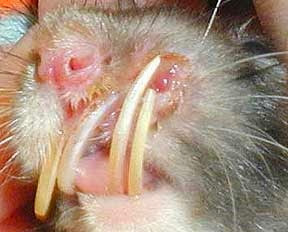Pet rat teeth can be downright problematic. Not all exotic pets have problems with their teeth but pet rats can. Rats have some teeth that grow continuously throughout their lives and these teeth may periodically require tooth trims if they are not naturally worn down, are damaged, or if your rat has a tooth alignment issue.
Dogs and cats are born with no teeth, develop deciduous teeth, and then lose those baby teeth so that their adult teeth can take their place. Rats, on the other hand, only have one set of teeth their entire lives. Their monophyodontal mouths start showing teeth at as young as eight days of age. These teeth, twelve molars and four incisors, remain in your pet rat's mouth for the rest of it's life. The molars never grow but the incisors continuously grow, sometimes causing problems for your rat.The incisors of a rat are naturally colored yellow and are harder than a human's teeth. Their upper incisors should be about four mm long and their bottom incisors almost twice that length at seven mm long. Much of the incisors are hidden underneath your rat's lips therefore in order to get a good look at their teeth you'll need to gently pull back their cheeks and lips to make sure the teeth aren't curling up and back into your rat's mouth or into the side of their cheek.
The incisors, or front teeth, are easy to identify when they become overgrown. They will usually grow so long that they begin to curve and stick out between the lips where they can become stuck on things, or worse yet, grow into the gums or roof of your rat's mouth. The molars, or teeth in the back of the mouth, do not grow so therefore they are not a problem like they can be in cavies and rabbits.
Most rats will wear their incisors down appropriately when they gnaw on their food but some rats are born with misaligned teeth, jaws, or suffer trauma at some point in their lives which inhibits normal gnawing action.
Incisor Tooth Trims
If done correctly, tooth trims are not painful. There are two common methods used to trim incisors. The first is by using regular dog nail clippers to cut the tooth like you would a toenail. This method is not the preferred way to trim teeth. There is a high risk of cracking or splitting the tooth because of the force needed to use the clippers. This method can cause pain if the tooth is split up to the nerve or is trimmed too short. The second method is by using a handheld rotary tool, like the Dremel, with a cut-off wheel to slice the excess tooth off. This method does require a bit more skill and anesthesia or sedation for rats since their mouths are so small but can be easily performed by a trained exotics veterinarian or veterinary technician. By using a rotary tool no trauma will occur to the tooth or nerve when cut. The only concerns are for trauma to the gums or lips if the wheel accidentally grazes them, or if the tooth is trimmed too short. This is why it is necessary to anesthetize rats to properly, and safely, trim their teeth.
Owners of rats and other exotic pets with teeth that continuously grow must be aware of the possible complications regarding their pet's teeth. Without the proper attention, overgrown teeth can cause serious trauma, anorexia, infections, pain, and even death from the inability to chew and swallow. Thankfully the problem of overgrown teeth is easily controlled with regular tooth trims and monitoring of tooth length.


Very interesting thank you. I learn something new every time I read your blog.
ReplyDelete